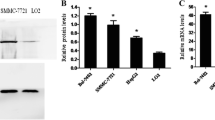Abstract
Purpose
Investigate the expression of hepatocyte cell adhesion molecule (hepaCAM) and vascular endothelial growth factor (VEGF) mRNA in 55 cases of urothelial carcinoma to examine the potential relationship between hepaCAM and VEGF in urothelial carcinoma.
Methods
Expression of hepaCAM and VEGF gene was determined by semiquantitative reverse transcriptase polymerase chain reaction (RT-PCR) in 55 paired urothelial carcinoma specimens. T24 cells stably expressing hepaCAM gene were established by Lipofectamine 2000. RT-PCR and western blot analysis were used to detect gene and protein expression of hepaCAM and VEGF before and after transfection. MTT test was used to detect the effect of hepaCAM gene on the cell proliferation.
Results
RT-PCR showed that hepaCAM expression level was significantly lower, and VEGF was significantly higher in urothelial carcinoma tissues than in adjacent tissues (P < 0.05, P < 0.05). hepaCAM and VEGF were strongly correlated with tumor stage (P < 0.05, P < 0.05). Spearman correlation analysis showed lower hepaCAM level was associated with higher VEGF level (r = −0.277 P = 0.041). Experiments with T24 cells in vitro demonstrated the expression of VEGF mRNA and protein were significantly decreased after transfection of hepaCAM gene (P < 0.05, P < 0.05). Expression of hepaCAM resulted in a significant inhibition of T24 cells proliferation (P < 0.05).
Conclusion
There is a close relationship between hepaCAM and VEGF in urothelial carcinoma. hepaCAM may be defined as a new target for diagnosis and anticancer therapy.



Similar content being viewed by others
References
Jemal A, Siegel R, Ward E et al (2007) Cancer statistics. CA Cancer J Clin 57:43–66
Parkin DM, Bray F, Ferlay J, Pisani P (2005) Global cancer statistics, 2002. CA Cancer J Clin 55(2):74–108
Reuter VE (2006) The pathology of bladder cancer. Urology 67:11–17. doi:10.1016/j.urology.006.01.37
Wang HV, Chang LW, Brixius K et al (2008) Integrin-linked kinase stabilizes myotendinous junctions and protects muscle from stress-induced damage. J Cell Biol 180(5):1037–1049. doi:10.1083/jcb.200707175
Minami K, Okano H, Okumachi A et al (2008) Role of cadherin-mediated cell-cell adhesion in pancreatic exocrine-to-endocrine transdifferentiation. J Biol Chem 283(20):13753–13761. doi:10.1074/jbc.M710034200
Götting C, Adam A, Szliska C, Kleesiek K (2008) Circulating P-, L- and E-selectins in pseudoxanthoma elasticum patients. Clin Biochem 41(6):368–374. doi:10.1016/j.clinbiochem.2007.12.009
Garver LS, Xi Z, Dimopoulos G (2008) Immunoglobulin superfamily members play an important role in the mosquito immune system. Dev Comp Immunol 32(5):519–531. doi:10.1016/j.dci.2007.09.007
Chung Moh M, Hoon Lee L, Shen S (2005) Cloning and characterization of hepaCAM, a novel Ig-like cell adhesion molecule suppressed in human hepatocellular carcinoma. J Hepatol 42(6):833–841
Crew JP (1999) Vascular endothelial growth factor: an important angiogenic mediator in bladder cancer. Eur Urol 35(1):2–8
Pignot G, Bieche I, Vacher S, Güet C, Vieillefond A, Debré B et al (2008) Large-scale real-time reverse transcription-PCR approach of angiogenic pathways in human transitional cell carcinoma of the bladder. Eur Urol [Epub ahead of print]. doi:S0302-2838(08)00637-4
Lee LH, Moh MC, Zhang T, Shen S (2009) The immunoglobulin-like cell adhesion molecule hepaCAM induces differentiation of human glioblastoma U373-MG cells. J Cell Biochem 107(6):1129–1138
Moh MC, Tian Q, Zhang T, Lee LH, Shen S (2009) The immunoglobulin-like cell adhesion molecule hepaCAM modulates cell adhesion and motility through direct interaction with the actin cytoskeleton. J Cell Physiol 219(2):382–391
Xun C, Luo C, Wu X et al (2010) Expression of hepaCAM and its effect on proliferation of tumor cells in renal cell carcinoma. Urology [Epub ahead of print] doi:S0090-4295(09)02927-6
Pasin E, Josephson DY, Mitra AP et al (2008) Superficial bladder cancer: an update on etiology, molecular development, classification, and natural history. Rev Urol 10:31–43
Pagliaro LC (2000) Gene therapy for bladder cancer. World J Urol 18(2):148–151
Izawa JI, Sweeney P, Perrotte P et al (2002) Inhibition of tumorigenicity and metastasis of human bladder cancer growing in athymic mice by interferon-beta gene therapy results partially from various antiangiogenic effects including endothelial cell apoptosis. Clin Cancer Res 8(4):1258–1270
Yang CC, Chu KC, Yeh WM (2004) The expression of vascular endothelial growth factor in transitional cell carcinoma of urinary bladder is correlated with cancer progression. Urol Oncol 22(1):1–6
Oliveira-Ferrer L, Tilki D, Ziegeler G, Hauschild J, Loges S, Irmak S et al (2004) Dual role of carcinoembryonic antigen-related cell adhesion molecule 1 in angiogenesis and invasion of human urinary bladder cancer[J]. Cancer Res 64(24):8932–8938
Das Kakoli, Zhao Yi, Sugiono Marto et al (2007) Differential expression of vascular endothelial growth factor165b in transitional cell carcinoma of the bladder. Urol Oncol 25(4):317–321. doi:10.1016/j.urolonc.2007.01.015
Slaton JW, Millikan R, Inoue K et al (2004) Correlation of metastasis related gene expression and relapse-free survival in patients with locally advanced bladder cancer treated with cystectomy and chemotherapy. J Urol 171(2):570–574
Conflict of interest statement
The authors declare that they have no conflict of interest.
Author information
Authors and Affiliations
Corresponding author
Rights and permissions
About this article
Cite this article
Yang, S., Wu, X., Luo, C. et al. Expression and clinical significance of hepaCAM and VEGF in urothelial carcinoma. World J Urol 28, 473–478 (2010). https://doi.org/10.1007/s00345-010-0573-z
Received:
Accepted:
Published:
Issue Date:
DOI: https://doi.org/10.1007/s00345-010-0573-z




